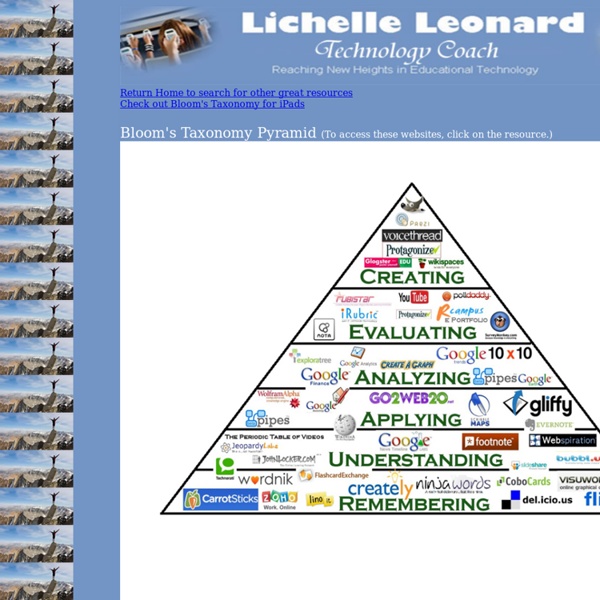



http://www.res.rcs.k12.tn.us/teachers/leonardl/blooms_pyramid.html
Related: Information Research • TACOak Harbor, Washington INFORMATION SKILLS This document was developed as part of a consulting assignment with the library media staff of the Oak Harbor (WA) Schools, who wished to create a rating scale which would help them assess how well students are performing on the tasks associated with the Research Cycle . The document is copyrighted by the Oak Harbor Schools and by Jamie McKenzie, but copies may be made by schools for distribution to staff. Any other duplication or transmittal in any form is prohibited unless permission is granted expressly. 1.
Bloom's Digital Taxonomy As educators we are all familiar with Bloom’s Taxonomy, created in the 1950′s by Benjamin Bloom, and the more recently revised 2001 version adapted by Lorin Anderson. The original use of nouns was replaced by verbs and top level categories were re-arranged. Each category has a number of sub-categories containing key verbs associated with it: Remembering - recognising, listing, describing, identifying, retrieving, naming, locating, findingUnderstanding - interpreting, summarising, inferring, paraphrasing, classifying, comparing, explaining, exemplifyingApplying – implementing, carrying out, using, executingAnalysing – comparing, organising, deconstructing, attributing, outlining, finding, structuring, integratingEvaluating - checking, hypothesising, critiquing, experimenting, judging, testing, detecting, monitoringCreating – designing, constructing, planning, producing, inventing, devising, making
35 Digital Tools That Work With Bloom's Taxonomy Integrating technology in the classroom and engaging students in higher order thinking creates the ultimate learning experience for students. Bloom’s Taxonomy and digital tools creates an innovative learning environment where students are engaged in their assignments. The following is a list of digital tools as it relates to Bloom’s Taxonomy. 22 Great Places If You Teach Research Skills If you are a teacher-librarian or media specialist, you are the one responsible for making sure students have learned the proper research skills. Since all students need to how to do research, why are school districts still cutting jobs for our position? Once kids get to middle and high school, they need to know how to do certain things tied to research, including a bibliography, website evaluation, searching techniques and so much more. Below you will find sites to assist you in teaching research skills for all ages.Use the Teacher-Librarians tab at the top to find a megalist of stuff for you. The 6 Online Research Skills Your Students Need- from Scholastic Copyright, Fair Use and Research Skills for Elementary Students- LiveBinder
10 Search Engines to Explore the Invisible Web Not everything on the web will show up in a list of search results on Google or Bing; there are lots of places that their web crawlers cannot access. To explore the invisible web, you need to use specialist search engines. Here are our top 12 services to perform a deep internet search.
Google-Proof Questioning: A New Use for Bloom's Taxonomy The internet has revolutionized information collection. The answer to virtually any question or problem is at our fingertips. Google has made this possible. While I am a great admirer of Google and an avid user of its products, in a way, Google has made my life as a teacher a LOT more difficult. Let me explain.
Integrate iPads Into Bloom's Digital Taxonomy With This 'Padagogy Wheel' You’re going to want to turn on your printer and fire up a PDF viewer. This is just that good. It’s called the Padagogy Wheel and it offers a fantastically useful perspecitve on how to figure out which iPad apps work with Bloom’s Digital Taxonomy. Created by Allan Carrington, this thing is a monster and deserves some focused attention.
10 Great Tools for Academic Research You Should Know about 1- Zotero Zotero is the only research tool that automatically senses content, allowing you to add it to your personal library with a single click. Whether you're searching for a preprint on arXiv.org, a journal article from JSTOR, a news story from the New York Times, or a book from your university library catalog, Zotero has you covered with support for thousands of sites. 2- Endnote EndNote gives you the tools you need for searching, organizing and sharing your research.
100 Useful Tips and Tools to Research the Deep Web By Alisa Miller Experts say that typical search engines like Yahoo! and Google only pick up about 1% of the information available on the Internet. The rest of that information is considered to be hidden in the deep web, also referred to as the invisible web.